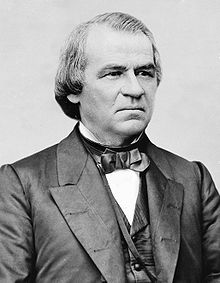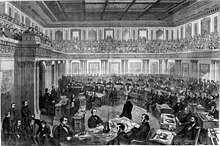Tenure of Office Act
The Tenure of Office Act of 1867 was a US -amerikanisches federal law , the dismissal of ministers from the Cabinet regulated. It gained notoriety in particular through the impeachment proceedings against President Andrew Johnson , who was accused of violating it. In 1887, Congress repealed the law. Later, in 1926, the Supreme Court invalidated a bill similar to the Tenure of Office Act but not affecting cabinet posts.
history
The Tenure of Office Act was first passed by the US Congress in 1867, against which President Andrew Johnson vetoed . His objection to the law could, however, be overruled in both the Senate and the House of Representatives with the required two-thirds majorities. Since the Democrat Johnson took over the office of the murdered Abraham Lincoln in April 1865 , of which he had been Vice President , there had been considerable tensions between him and the Republican- dominated Congress regarding post- Civil War politics (1861-1865) ( Reconstruction ) . The enacted law stipulated that in future the president would need the approval of the Senate to dismiss ministers. So far, only the appointment to minister had required confirmation from the Senate. The newly enacted Tenure of Office Act even made it impossible for the president to dismiss a minister while Congress was not in session. (Back then, the US legislature met much less often than it does today.)
When there was a considerable disagreement between Johnson and his Secretary of War Edwin Stanton in August 1867, the Senate was not in session , Johnson decided to suspend the minister from office. When the Senate met for the next time in January 1868, it refused to approve the dismissal of the Minister of War. However, President Johnson ignored this and tried to appoint a new minister. Members of Congress who opposed Johnson's Reconstruction policy saw their chance to remove the unpleasant head of state through impeachment for violating the Tenure of Office Act . Since the President cannot simply be voted out of office by Congress (e.g. through a vote of no confidence ), impeachment appeared to be the only way to remove the President from office before the end of his term of office. After the three-month trial, during which further allegations against Johnson were loud, Johnson was able to narrowly avoid impeachment. In the Senate, the President's opponents missed the required two-thirds majority with a single vote. However, even at that time it was legally controversial whether Secretary of War Stanton would fall under the law at all, since his appointment was made by President Lincoln long before the Tenure of Office Act came into force.
Stanton resigned from his cabinet post in May 1868 and Johnson resigned from office in March 1869 after his party, the Democrats, failed to nominate him for reelection for the 1868 election.
Repeal and further history
In 1887, Congress revoked the Tenure of Office Act , which repealed it. In 1926, the United States Supreme Court ruled unconstitutional a similar law affecting senior officials . As the judges in the Myers v. United States found, the President needs the approval of the US Senate for their appointment, but not for their dismissal.
Individual evidence
- ^ A b AmericanPresident.org Andrew Johnson
- ↑ a b Law2.umkc.edu The Tenure of Office Act of 1867
- ^ Case law - find law: Myers v. United States

